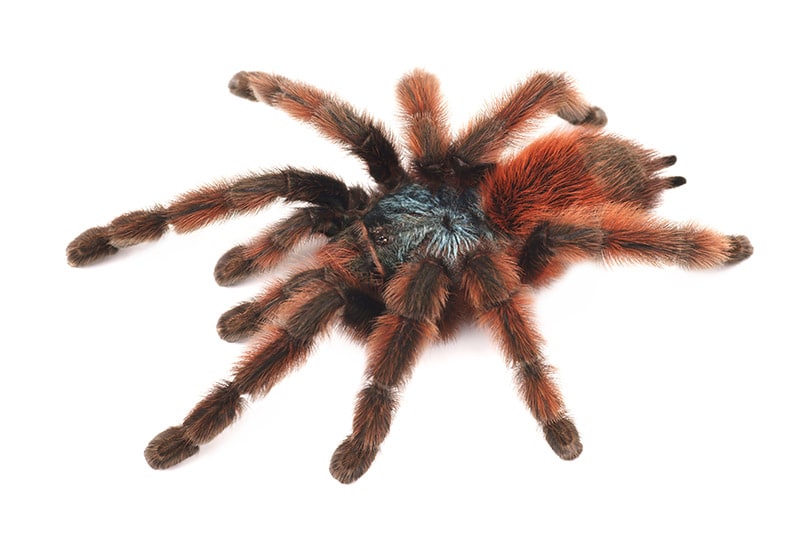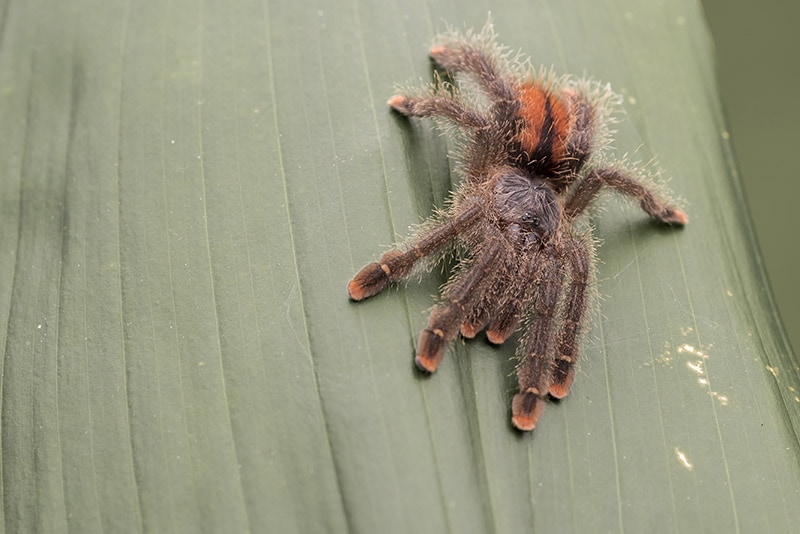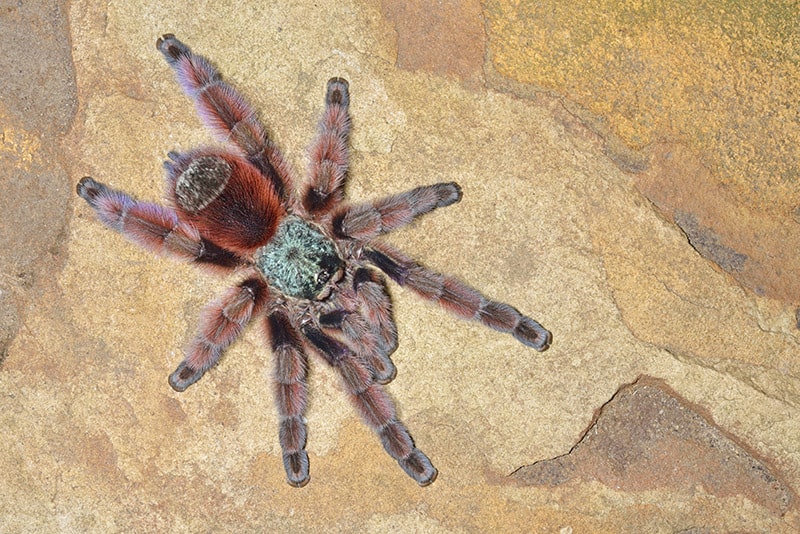The Pink-toed Tarantula is Energetic and friendly, making it fun to keep!
The Pinktoe Tarantula Avicularia avicularia one of the most rewarding species of tarantula to keep in captivity. It is highly prized for its color and personality. This tree spider is a beautiful furry species that is dark black to metallic gray overall with deep violet to reddish hues to the abdomen and leg hairs. But its distinctive feature are the wonder pinkish tips on each foot, giving it the names “pinktoe” and “pink-toed” tarantula.
Pinktoes reach a moderate size as adults. Females can grow to about 5″ (13 cm) with males being just a bit smaller, reaching about 3.5″ (9 cm). They reach maturity in 2 to 3 years and are estimated to live between 4 to 8 years. They are fun to keep, because unlike most tarantulas, they can be kept in groups.
The Pink-toed Tree Spiders are docile and hardy. They are active during the day and will build extensive web tubes in their enclosure. Though they are much more docile than their close cousin the Antilles Pink Toe Tarantula they will jump, so care should be taken when handling them.
These tarantulas are favorites because they are easily handled, and entertaining if kept properly. But as with the other species of Avicularia, the Pink-toed Tarantula is a little more challenging to keep. It requires the unique combination of high humidity and plenty of ventilation. This combination can be somewhat difficult to provide in captivity, to maintain these parameters requires a regular regime.
- For more information on keeping Tarantulas, see: Keeping Arachnids and Other Arthropods as Pets
Scientific Classification
| Kingdom: | Animalia |
| Phylum: | Arthropoda |
| Class: | Arachnida |
| Order: | Araneae |
| Family: | Theraphosidae |
| Genus: | Avicularia |
| Species: | avicularia |
Scientific Name

Habitat: Distribution/Background
The Pinktoe Tarantula Avicularia avicularia was described by Linnaeus in 1758. They are found in Brazil, Trinidad, Martinique, Guyana, French Guiana, Suriname, Venezuela, and throughout the Amazon Basin. Other common names they are known by are Pink-toed Tree Spider, Pink-toed Tarantula, and Guyana Pinktoe. Most of those available currently are imported from Guyana.
The Avicularia genus is the most widespread group of spiders in the Americas and contains about 20 species. This genus was also the very first of the tarantulas to be described by science.
Status
The Avicularia avicularia are not on the IUCN Red List for Endangered Species.
Description
The Pinktoe Tarantula is a moderately sized tarantula with long dense hairs. The females reach about 5″ (13 cm) and males are slightly smaller, reaching about 3.5″ (9 cm). They are a beautiful furry species that is an overall dark black to metallic gray. They can also have an attractive coloration on their abdominal and leg hairs varying from a shiny purple or deep violet to reddish hues, sometimes highlighted by yellows. Their most distinguishing feature is a wonderful pink to pink-orange tip to each foot.
Mature males are long-legged and often boast a fascinating black with metallic look to its hairy carapace and abdomen. Females are a bit stockier, even for an arboreal species. They mature in 2 to 3 years and are estimated to live between 4 to 8 years.
Food and Feeding
The Pink-toed Tarantula or Pink-toed Tree Spider is an aggressive feeder. It will eat a variety of insect prey including adult crickets, grasshoppers, roaches, and especially flying insects such as wax moths. In nature, they will also feed on small lizards such as Anolis species, but they are not typically fed vertebrate prey in captivity.

Housing
In the wild all the Avicularia species are primarily arboreal, They will live in human structures or on plants rather than on the ground. The Pink-toed Tree Spider should be kept in a large, vertically oriented enclosure. A modified aquarium or tall plastic storage tub will work well. Keep the enclosure dry and spray it lightly with water every few days. The cage should be allowed to dry out in between misting.
By keeping several live plants within the enclosure you can add to the humidity. These plants can be placed within the enclosure still in their pots or can be planted in the deep substrate. Not only do live plants provide some more humidity, they will provide excellent areas for breeding and egg-laying. Provide one or two shallow water dishes in the enclosure.
Temperature and humidity requirements:
This species will do best if you maintain the enclosure at 78° to 82° F with a humidity level of 65 to 75%.
Cage Care
A good habit to get into is cleaning up any uneaten prey items the day after feeding your tarantula as decaying organic matter commonly attracts mites, fungus, mold and other potentially harmful organisms into the enclosure. If your pet has recently molted, remove uneaten prey items immediately. Newly molted tarantulas are vulnerable until their exoskeletons hardens.
Behaviors
These are fun to keep because unlike most tarantulas, they can be kept in groups if you keep them in a large enough terrarium and keep them well fed. Pink-toed Tarantulas are one of the most docile of the arboreal species. Many of the other Avicularia species are more aggressive and will race away or even bite.
Handling
The Pink-toed Tarantula, as an arboreal species, are very agile and active. They are quite docile if not handled roughly or pinned with their fangs near your skin. They do tend to be nervous and jittery when handled and are prone to jumping from hand to hand, hand to shoulder, or in extreme cases, from hand to floor (which can be dangerous). They will jump, so care should be taken when handling them. As with other Avicularia species, Pink Toes are also fond of shooting a small spray of fecal matter as a defense.

Reproduction
As with most tarantula species, the male Pink-toed Tarantula is thinner and has long, furry legs. He is equipped with hooks on his first pair of legs. These hooks are used to grapple with the female’s fangs during courtship and mating. A female remains bulky and less spindly as she grows.
An adult male should be carefully introduced into the female’s enclosure after he has produced a sperm web. The male can be protected with a piece of cardboard or other tool if he is to be used for further breeding attempts. Once mating occurs, the female should be fed a variety of prey on a more frequent schedule.
The Pink-toed tarantula will breed fairly readily. They lay between 50 to 200 eggs that hatch in six to eight weeks. The spiderlings are pretty good size and can easily be raised with crickets.
Diseases: Ailments/Treatments
Tarantulas are generally quite hardy and adaptable if they are provided with the right environment. A few signs that may indicate that your pet is not acting or feeling normal are a loss of appetite, lethargy, looking overly skinny, or pacing the enclosure.
A tarantula on its back is probably not sick. Most tarantula species flip onto their backs during molting. Though this is a very stressful and delicate time for tarantulas, if the humidity and warmth levels are correct, they will molt their exoskeleton, roll over, harden up, and within a week or two be ready for their next meals.
Molting
One of the most common reasons for your pet to demonstrate unusual behavior is due to a molting period. As they outgrow their existing skin all tarantulas regularly go through an extensive molt, shedding their entire skin as well as the linings of their mouth, respiratory organs, stomach and sexual organs.
The process starts well before the actual molt. For several weeks prior to shedding they will be growing a new skin under their old one. During this time it is not unusual for a tarantula to get quite lethargic and even stop eating. There may also be lots of web spinning activity as they prepare to molt.
When they begin to molt, they lay on their backs with their legs up in the air looking as if they are dead. Be sure not to disturb your tarantula when you see this. The shedding process goes quickly and smoothly as long the environment has adequate humidity.
Once they have shed, their new skin is pale and very soft. The amount of time it takes for your pet to fully recover and be back to eating well will vary from a day or so up to several weeks depending on its size. Smaller spiders recover much quicker than larger ones.
Other Problems
Other problems are usually the result of some type of environmental stress. There may be a drop in the temperature of the enclosure, there may be parasites, or the tarantula may just not be comfortable with the depth of its hiding place. These things can be easily adjusted or changed, or you can try moving your pet to a new enclosure.

Availability
The Pink-toed Tarantula was at one time the most abundant pet spider in the hobby. It has a large range and was imported by reptile dealers in large numbers for many years in the 1980s and 1990s. As importation has declined, it is now not commonly seen as an import but luckily is being bred in some numbers by hobbyists in the United States and Europe and is often available as captive-bred spiderlings.
Featured Image Credit: Dean Pennala, Shutterstock
